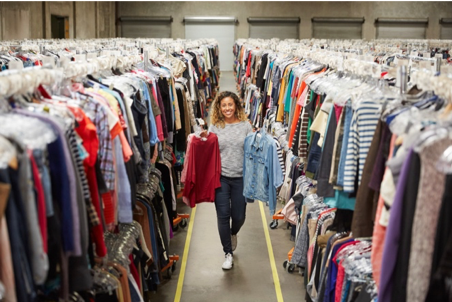by Alexia Khan
The fashion industry’s penchant for cheap mass-produced clothing has some serious consequences for the environment, and marginalized communities throughout the world. According to the UN Environment Programme, Fast-fashion is a major contributor to global green house gas emissions, environmental degradation, and labour inequality, and it puts even more stress on an already fragile global ecosystem. To put that into perspective, the fashion industry consumes more energy than the shipping and aviation industries combined! Luckily, the industry as a whole is slowly starting to face this reality, and is seeking out better ways of doing things. One potential solution to this complex issue is the resale market.
For many of us, the mention of resale might conjure up images of cramped and musty thrift stores. But the resale market emerging today comes in many different forms, and offers both consumers and producers unique opportunities to reduce their environmental impact while supporting ethical and responsible businesses.
Traditionally, resale has been limited to brick-and-mortar consignment stores, but technology, the internet and apps are allowing the industry to grow faster than ever before, reaching a much larger and more diverse customer base. A quick search for ‘vintage’ on instagram will reveal thousands of perfectly curated accounts reselling anything from tank tops to luxury handbags. Facebook’s digital marketplace now allows people to buy and sell clothing from others in their area. Platforms like these make it easier for people to find the products they want, without having to necessarily buy them new.
The rise of resale has also led to the emergence of companies like the RealReal and LXR & Co, who buy and sell high-end clothing and accessories through their e-commerce platforms. These types of services give customers the value and choice that they want, while extending the lives of beautiful luxury items. Customers can indulge in the latest trends and most sought-after pieces, while still acting sustainably.
Another impact that technology has had on the resale market has been the growth of companies like ThredUP, which is now considered to be the world’s largest online thrift store. ThredUP’s facility receives over 100k items EVERY SINGLE DAY, and their logistical technology allows them to process more than 1 item per second.
That’s a lot of clothing! Even better, that’s a lot of clothing diverted from the landfill.
Once items are photographed, they’re organized by brand and style, and added to the website, ready to be purchased!
We asked ThredUP what they believe sets the digital resale market apart from traditional second-hand. For them, the biggest difference is in the overall shopping experience. Customers no longer have to spend hours scanning the racks at used clothing stores.

They explained that “the biggest hurdle [they] have faced over the past ten years has been breaking down the stigma of second-hand. In order to convert the skeptics [they] set out to make buying used clothing online just as easy and fun as buying new clothing. With 35,000 brands across more than 100 product categories, [they] are giving customers the value and variety they crave without the waste.”
Whatever it is, it seems to be working. According to their 2019 Report, resale has officially gone mainstream. Stats show that Millennials and Gen Z’ers are adopting second-hand 2.5x faster than the average consumer, and that the value of the second-hand market will outgrow fast fashion within the next decade. Younger generations want more socially and environmentally conscious options, but they also want the variety and accessibility that fast fashion offers. Resale has the potential to align with those values, in a way that is still affordable and fun.
In addition to providing shoppers with a better resale experience, sites like ThredUP are also making it possible for brands to participate in the second-hand market themselves. Retailers can provide their customers with “Clean Out Kits” that they can fill with gently used clothing to send to ThredUP in exchange for shopping credits. The kits give shoppers a way to clean out their closets, but most importantly, they divert perfectly good clothing away from landfills and help to create a more circular system.
So far the program has been a success, and has led to partnerships with fashion cult favourites like Polarn O Pyret and Amour Vert. Many clothing companies wish to transition to a more circular supply chain, but simply don’t know where to begin. ThredUP’s recycling framework reduces some of the barriers to entry, and makes it possible for more brands to participate on a larger scale.
For instance, companies like Reformation are tapping into ThredUP’s infrastructure as a way to achieve more circularity within their company. In 2020, they signed the Circularity Fashion System Commitment Letter with the goal of recirculating 75,000 garments by the end of the year. ThredUP’s recycling program supports this goal, while providing customers with RefCredit as an incentive. Besides the partnership, Reformation has also been playing around with the idea of resale.
We asked the team if they have considered incorporating resale into their business model, as we are starting to see with outerwear companies such as Patagonia and Arc’Teryx. They said it’s definitely something they’re exploring. “[They] currently have 2 stores selling curated vintage clothing, and [their] customers have always responded well to the selection and one of a kind finds.”

In the meantime, they are encouraging their customers to use resale platforms like ThredUP.
All that being said, the resale market is not a single perfect solution for all of fast fashion’s problems. In order for the resale market to truly have an impact, consumers have to start shifting their purchasing habits. The choice to buy something second-hand only makes a difference when it’s in place of buying something new. The risk is that consumers will view the resale industry as yet another reason to shop, and with less guilt.
What we truly need is a more mindful approach to shopping. Consumers must slow down and invest in quality clothing with the intention of keeping it for years and years, which also means caring for it better. This new mindset, in combination with more responsible manufacturing and the rise of the resale market, is our best hope towards achieving a more sustainable fashion industry.

